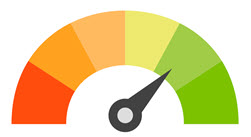WHAT IS HOME EQUITY?
Your home is probably your biggest asset. Because it is an asset, you may be able to borrow money using your home as security. Owning a home is an asset because homes generally increase, or appreciate, in value. As the years go by and you pay your mortgage down, your home equity potentially increases.
Equity is the difference between how much your house is worth and how much you still owe for it. This means you may be able to borrow money using your home as collateral. (Collateral is something you promise to give to a lender if you can’t pay back the loan.) Some reasons you may want to borrow against your home include paying down your high-interest debts, home renovations and paying for other major expenses.
If you do borrow against your home’s equity, be sure to make your home equity payments on time and in full. Otherwise, you may risk losing your home. Use this ability to borrow responsibly, and you’ll have a whole new level of flexibility to achieve your financial goals.

HOME EQUITY LOANS & LINES
Use this chart to compare two different ways of borrowing against the equity in your home.
| Home equity loan (Second mortgage) | Home equity line of credit |
| Provides a lump sum of money Your lender will provide a lump sum. | Provides revolving credit, a type of credit that allows an individual to borrow up to a certain amount of money, repay the money borrowed with interest when it is due, and then borrow the money again. |
| Uses your home as security Your home secures the loan. | Uses your home as security Your home secures the loan. |
| Must pay back by certain date Your lender will specify a due date. | Repayment options may vary Your lender will explain your repayment options. |
| Often used for a project Home equity loans may be used for one specific purpose, like remodeling the house or a wide variety of purposes ranging from home improvements to college education. | Various uses Homeowners use their home equity lines of credit for a wide variety of purposes ranging from home improvements to college education. |
| Higher interest than first mortgage The interest rate on a second mortgage is usually higher than on a first mortgage. Different financial institutions may offer different rates. Shop around. | Interest rates vary Different financial institutions may offer different rates. Shop around. Some lines of credit have fixed interest rates; others have variable rates. |
| Tax deductible interest Home equity loans may be tax-deductible if your mortgage debt is within government limits and the borrowed money was used to buy, build, or improve your home. Check with your tax advisor. | Tax deductible interest A home equity line of credit may be tax-deductible if your mortgage debt is within government limits and the borrowed money was used to buy, build, or improve your home. Check with your tax advisor. |
BORROWING ON YOUR HOME EQUITY
If you own a home, you may be able to use the equity in your home as a source of financing. Home equity is the financial difference between what your home is worth and the amount of money you still owe as debt on that home. For example, if your home is worth $100,000 and you owe $75,000 on your mortgage, then you have $25,000 of equity in your home.
If you use this ability to borrow wisely, you’ll have a whole new level of flexibility to achieve your financial goals.
The information contained herein is being provided as-is and without representation or warranty. The enclosed information is not intended as legal, tax or financial planning advice. Any discussion of tax or accounting matters herein (including any attachments) should not and may not be relied on by any recipient or reader. The recipient/reader should consult their tax adviser, legal consultant and/or accountant for a statement of tax and accounting rules applicable to their particular situation and for all other tax and accounting advice.
